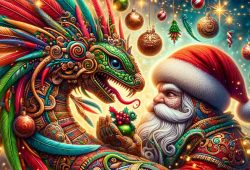The poinsettia is a symbol of Christmas. For many households, it is an essential element in the Christmas celebration. However, care must be taken with this plant and our pets. A common question is whether the poinsettia is poisonous to dogs or cats.
Is the poinsettia toxic for dogs and cats?
Yes, the poinsettia, or Nochebuena flower, is toxic to dogs and cats. The sap of the plant contains a substance called calcium oxalate, which can cause irritation of the mouth, tongue, stomach, and intestines. In severe cases, poinsettia poisoning can lead to vomiting, diarrhea, lethargy, seizures, and even death.
Signs of poinsettia poisoning usually appear between 12 and 24 hours after the pet has ingested the plant. If your dog or cat has been in contact with the poinsettia, it is important to take them to the veterinarian as soon as possible.
There are some things you can do to help prevent poinsettia poisoning in your pet:
- Keep the poinsettia out of reach of pets.
- If you have pets, place the poinsettia in a high spot where they cannot reach it.
- If your pet has access to the poinsettia, closely monitor for any signs of poisoning.
- If your dog or cat has ingested the poinsettia, follow these steps:
- Call your veterinarian or the animal poison control hotline.
- If your pet is vomiting, offer them water to drink to prevent dehydration.
- If your pet is showing signs of poisoning, such as lethargy or seizures, take them to the veterinarian immediately.
- Poinsettia poisoning is a veterinary emergency, but with prompt treatment, most pets recover completely.
What dos a poinsettia symbolize?
The poinsettia, a plant with striking red and green foliage, carries various symbolic meanings, particularly in the context of Christmas and its cultural origins in Mexico:
- Christmas celebration: The most widespread symbolism of the poinsettia is its association with Christmas. The plant’s red and green color scheme naturally complements traditional Christmas decorations. Its blooming season aligns with the Christmas holiday, making it a popular choice for festive decor.
- Star of Bethlehem: The shape of the poinsettia’s leaves, often thought to resemble a star, is commonly linked to the Star of Bethlehem from the Nativity story. This association gives it a religious significance in Christmas celebrations.
- Joy and hope: In the context of the holiday season, poinsettias symbolize joy, hope, and goodwill, reflecting the festive and positive spirit of Christmas.
- New life and renewal: In some interpretations, especially in its native context in Mexico, the poinsettia is seen as a symbol of new life and renewal, given its blooming in the midst of the winter season.
- Success and celebration: In some cultures, the bright red color of the poinsettia is associated with success and celebration, making it a fitting plant for festive occasions.
Where are the poinsettias from?
Poinsettias (Euphorbia pulcherrima) are native to Mexico and Central America. They were known to the Aztecs as “Cuetlaxochitl” and were used for various purposes, including medicinal uses and as a dye. In their native habitat, poinsettias are perennial shrubs that can grow up to ten feet tall.
The plant was introduced to the United States in the 1820s by Joel Roberts Poinsett, the first U.S. Minister to Mexico, after whom the plant is named. Poinsett, who was also a botanist, sent cuttings of the plant he discovered in Southern Mexico to his home in South Carolina. The plant’s association with Christmas began in 16th-century Mexico, where legend tells of a young girl who was too poor to provide a gift for the celebration of Jesus’ birthday and was inspired to gather weeds from the roadside that miraculously bloomed into bright red flowers.
Today, poinsettias are not only a popular holiday plant in Mexico and the United States but are also widely grown and appreciated worldwide for their vibrant seasonal color, particularly during the Christmas season.
YOU CAN READ.The curious case of the Poinsettia, a mexican flower patented in the United States
How often water a poinsettia plant?
Watering a poinsettia plant properly is crucial for its health and longevity. Here are some guidelines for watering poinsettias:
- Check the soil: Water the poinsettia whenever the surface of the soil feels dry to the touch. Stick your finger about an inch into the soil; if it feels dry, it’s time to water.
- Water thoroughly: When watering, do so thoroughly until the water drains out of the holes in the bottom of the pot. This ensures that the entire root ball is moistened.
- Avoid waterlogging: After watering, let the excess water drain out and then discard any water left in the saucer. Poinsettias do not like to sit in water, as this can lead to root rot.
- Monitor frequency: The frequency of watering will depend on factors like the size of the plant, the size of the pot, the temperature, and humidity of the environment. Typically, poinsettias need to be watered once a week, but this can vary. In warmer, dryer conditions, they may need more frequent watering, while in cooler or more humid environments, they may need less.
- Seasonal adjustments: Remember that indoor heating can dry out plants more quickly in the winter, so you may need to water more frequently during the plant’s blooming period (usually around Christmas).











